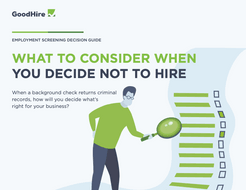Common Adverse Action Mistakes: Navigating Legal Compliance
Failing to follow adverse action procedures is a major cause of class-action employment lawsuits. Here’s what you need to know to protect your company from legal liability.
Karen Axelton
8 min read
When employers decide against hiring a candidate due to information discovered in a background check, federal law requires furnishing that information in an adverse action notice. Learn how GoodHire’s built-in compliance workflow simplifies and streamlines the process for you.
If you’re an employer who is considering taking unfavorable action against a job applicant or employee– such as not hiring or promoting, or firing the individual–because of information found in a background check, you must follow a legal process called adverse action. Whenever such a decision is based on information from a background screening, employers are required to comply with steps laid out in the federal Fair Credit Reporting Act (FCRA).
Not only are these steps required under the FCRA, but many states, cities, and other jurisdictions have their own laws governing adverse action. Failing to comply with adverse action rules is a major cause of employment lawsuits. Each willful violation of the FCRA can cost an employer up to $1,000 in statutory damages. For large organizations that hire at high volume or in multiple states or cities, the price of running afoul of adverse action laws can quickly add up.
Considering adverse action laws in both your location and the candidate’s location can be challenging for any HR team. Ban-the-box laws vary by jurisdiction, so it’s critical to understand whether these laws may affect your organization (and how). For example, some local ban-the-box laws require longer waiting periods than the 5 day minimum required by the FCRA.
To simplify compliance with complex geographic requirements, GoodHire’s Integrated Adverse Action automatically incorporates laws from more than 30 states and 180 municipalities. We even send you an alert when you can legally take the next step in the process. By following these built-in steps, you can help ensure fair hiring decisions while protecting your company from liability. You may also wish to consult with your own legal counsel regarding your adverse action process.
Here’s a closer look at GoodHire’s Integrated Adverse Action workflow:
Our Targeted Screening feature enables you to evaluate the specific record(s) that prompted you to consider pursuing adverse action. Start by selecting from the list of potential records, by varying levels of severity and amount of time passed since the crime was committed. Next, specify the position you are looking to fill and the nature of the job in question. Lastly, you have the option to send a customizable message to the candidate requesting additional information about the record(s) in question.
If state or local adverse action laws require specific forms for adverse action compliance, GoodHire will provide the necessary forms for you. Simply download, complete the required fields, sign, and re-upload.
GoodHire provides a pre-adverse action notice that includes A Summary of Your Rights Under the Fair Credit Reporting Act, a copy of the background check results, and an explanation of what the candidate should do next. Review and send!
Once the applicant has had sufficient time to respond, you’ll need to make a final decision. Use any additional information or context that the applicant provided to conduct an Individualized Assessment, which the Equal Employment Opportunity Commission (EEOC) encourages and many state and local fair hiring laws require. This includes providing supplementary information to explain your decision.

Upon completing an individual assessment, employers have the opportunity to review and send their final adverse action notice to the candidate.
Employers can speed time-to-hire with customizable templates and automated alerts, while also enjoying peace-of-mind knowing they’re mitigating legal risk with built-in geographic compliance and a digital paper trail. But, candidates benefit too:
GoodHire’s built-in compliance features go beyond adverse action, and also include:
At GoodHire, we know it can be difficult to stay on top of constantly changing employment laws. By streamlining the adverse action process and guiding you through each step, we help you reduce risk, save time, and provide a positive candidate experience. Our adverse action workflow is just one of the ways we help you make smart, compliant hiring decisions. To learn more about how GoodHire is your compliance partner, contact our sales team.
The resources provided here are for educational purposes only and do not constitute legal advice. We advise you to consult your own counsel if you have legal questions related to your specific practices and compliance with applicable laws.
Failing to follow adverse action procedures is a major cause of class-action employment lawsuits. Here’s what you need to know to protect your company from legal liability.
Employers must get written consent before conducting background checks. GoodHire offers 3 easy, FCRA-compliant options for consent.
What does adverse action mean in hiring? Learn the steps employers must follow when taking adverse action, and the rights of job candidates who receive adverse action notices.